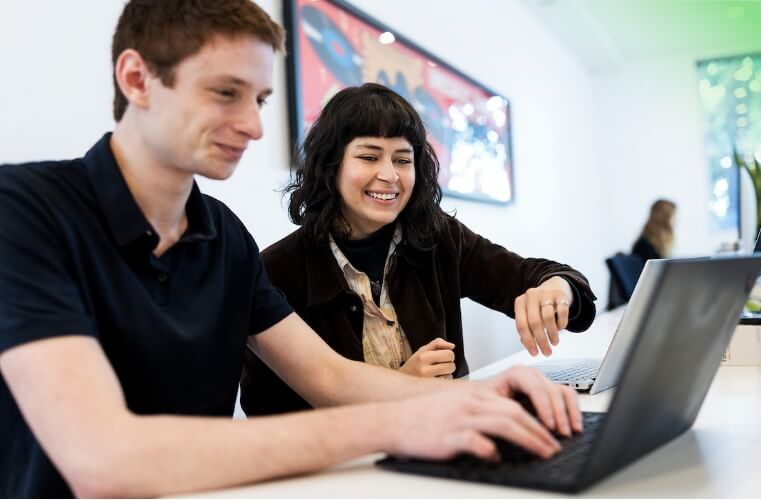Keen to know more
about our Full Service?
Our world class qualitative user testing can help explain the why behind your data and give you the answers to your burning questions.
As social media platforms like Twitter, Facebook, and Instagram continue to grow in popularity, the prevalence of infinite scrolling has continued to rise. While web users have become savvier when it comes to scrolling through pages, it does not mean that infinite scrolling is the end all be all for websites of today. 74% of viewing time is still spent in the first two screenfuls. The importance of the page fold is not dead yet. Here’s how to keep the attention of your users and make sure you get the most important information across.
How willing are people to scroll?
In 2010, eye-tracking studies from NNG showed that 80% of users’ viewing time was spent above the fold. That number has since decreased to 57% in 2018. Web users are becoming more accustomed to longer pages and are comfortable with scrolling. However, sharp decreases in attention to information as you go further below the fold are present in both findings. Prioritising the most essential information at the top of the page is the best way to get your message across to your users. This is especially the case for search engine result pages (SERPs), where 75% of viewing time was spent on the top half of the first page. “Google gullibility” has not changed since 2010, meaning that it’s still imperative to appear at the very top of search pages to be relevant. So what factors prevent people from scrolling and giving their attention?
Illusion of completeness
The illusion of completeness is when the visible content on-screen appears to be complete, even though there is more information below. Careful design with your user’s short attention spans in mind can help you avoid this problem. The prominence of image-based design has resulted in a lot of landing pages choosing to incorporate eye-catching, fullscreen hero graphics. While visually appealing, this approach often forces important information to get pushed down the page. Considering how valuable real-estate in the minds of your users is, this is not an efficient way to get your point across. Likewise, large chunks of white space or dividing lines between content can indicate to your user that they have reached the end. Be cognizant of your usage of white space/dividers and have additional content bleed off the screen to indicate that your page has more information. Also, interruptions in content flow such as ads or CTAs in the middle of articles can signify that the post is over. While it is important to have CTAs above the fold (or as close to it) for your users to see, give a proper indication that there is more information for them down below as well.
Minimising interaction cost
The interaction cost is defined as the sum of effort that the user must put in to complete a task and reach their goal. Interaction costs can be both mental or physical. Clicking, scrolling, loading, and even comprehending information are all actions that require some interaction cost. The most usable sites and apps focus on minimising interaction costs wherever possible. It is important to understand how users decide what option to pick and work backward. In order to make decisions, people are constantly assessing the expected utility of each function of your site.
Expected utility = Expected benefits – Expected interaction costs
In short, users look to maximise utility by weighing the benefits and costs of each action. If you make it difficult for a user to reach their end goal on your site, most users will move to another site with higher expected utility. The exception to this rule is if the benefit of interacting with the initial site is high. For example, someone looking to buy a specific band’s tour merch will likely stick to the band’s website because it is unlikely they could buy it elsewhere. Therefore, maximising expected utility requires efforts from both marketing and design teams. Marketing and branding are responsible for increasing user motivation and expected benefits for engaging with your particular site, whereas usability design deals with optimising interaction costs.
So how do you minimise interaction cost when presenting a user lots of important information? The trick to keeping the attention of your users where you want it is about balancing scrolling and pagination. While the tops of pages are the most viewed sections of your site, clicking requires a higher interaction cost than scrolling. Alternatively, having too much or poorly organised information is less likely to be read the further you have to scroll down.
The “ideal” page length
Is there an ideal length for web page content? The short answer is no. Every site has different users and serves a different purpose. E-commerce sites where each item has equal importance to the user can get away with longer pages. Hence the popularity of the view all option when online shopping. Government and insurance sites offering self-service for users looking for specific solutions require structured UI and multiple pages. Web users do not mind clicking links if each click is meaningful and leads them closer to their end goal. The key is to test your design, with real people who are representative of your actual users, to identify the “ideal” page length so that your users can find the information they need easily.

Our world class qualitative user testing can help explain the why behind your data and give you the answers to your burning questions.